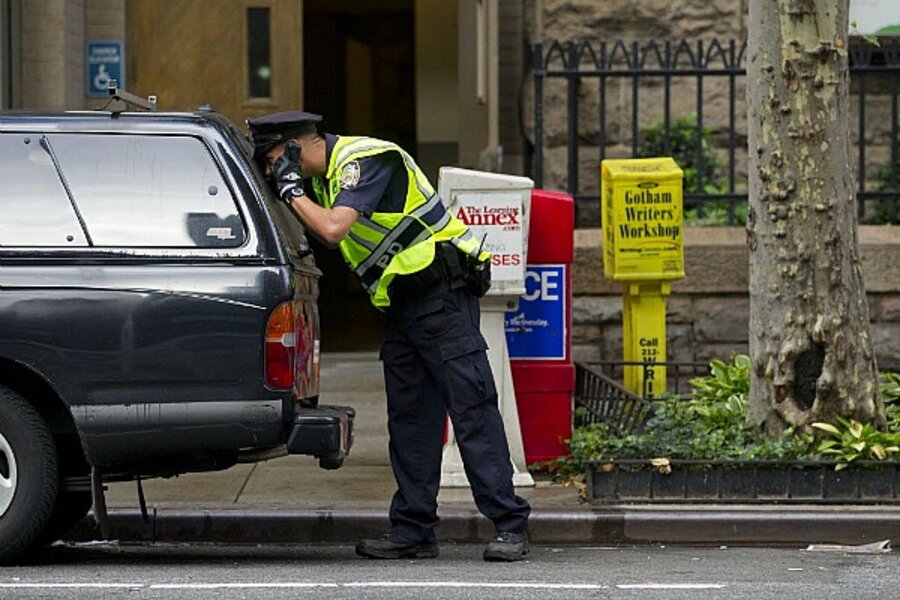Response to 'credible threat' shows how much has changed since 9/11
Loading...
On Thursday, federal and New York City authorities disclosed that the U.S. had received specific and credible but uncorroborated intelligence indicating three individuals may have entered the U.S. as part of a possible plot to attack Washington or New York on the tenth anniversary of the September 11, 2001 attacks.
Nothing may come of the threat, but national, state, and local law enforcement agencies are taking no chances.
In New York, police are paying particular attention to bridges and tunnels, checking vehicles. Armed transit police and National Guard troops are patrolling Penn Station. Unattended cars parked suspiciously in Washington are being towed, and police there are working 12-hour shifts.
The reason authorities are paying such close attention to the most recent threat may not be because of newly gathered intelligence alone, but rather from a steady string of lower-level attack threats in the US since 9/11, plotted by individuals and small groups inspired by Al Qaeda.
Al Qaeda’s capabilities may have been degraded in the years since 2001, says Amy Zegart, professor of public policy at UCLA's School of Public Affairs and a senior fellow at Stanford's Hoover Institution. But the group once led by Osama bin Laden has since “morphed into a more complicated, decentralized and elusive threat” including affiliates or franchise groups operating in places like Yemen and Somali and “homegrown terrorists inspired by violent extremism, often through the Internet in the comfort of their own living rooms,” she writes this week in a Los Angeles Times column.
“Plots by homegrowns and franchise groups have risen dramatically in recent years,” she writes, pointing to the Ft. Hood shootings, the Christmas Day “underwear” bomber, the plot to explode printer cartridges on cargo planes, and the Times Square bomb plot.
There have been other attacks and attempted attacks as well: the Somalia-born teen who plotted to explode a bomb in the Portland, Ore., Pioneer Courthouse Square just as families had gathered for a Christmas tree lighting; the shooting of two US military recruiters in Little Rock, Ark.; the arrest of Army Private 1st Class Naser Abdo with guns and explosives near Fort Hood, Texas, last July; the arrest a month earlier of two men – US citizens who had converted to Islam – who tried to acquire machine guns in order to attack the Military Entrance Processing Station just south of Seattle.
From September 11, 2001 to May 2009, US authorities reportedly uncovered 21 plots, and in the past two years they have made arrests in connection with at least 33 more.
In a report for the Bipartisan Policy Center last September, national security experts Peter Bergen and Bruce Hoffman called 2009 a “watershed year in terrorist attacks and plots in the United States” with a total of 11 jihadist attacks, plots, or efforts by Americans to travel overseas to receive terrorist training. That year, at least 43 Americans or residents aligned with Sunni militant groups were charged or convicted of terrorism crimes.
What’s more, Bergen and Hoffman reported, would-be jihadists were not necessarily poor, uneducated, or without opportunity, as many had assumed after 9/11. Nor did they fit any particular ethnic profile. Of the 57 individuals charged or convicted between January 2009 and when their report was made in September 2010, more were Caucasian-Americans, than were Arab-Americans. (The largest portion – 31 percent – were Somali-Americans.)
At a recent Monitor-sponsored press breakfast, Homeland Security Secretary Janet Napolitano said, “Categorically the country is safer now that it was prior to 9/11.”
“We have many layers of security in place that didn’t exist before, beginning with intelligence gathering and information sharing,” she said.
But like virtually every expert on national security and domestic terrorism, Ms. Napolitano says the toughest problem remains the single individual or small group who may not have the ability to carry out mass attacks but who could slip through intelligence nets and do considerable damage.
"It is much more difficult to defeat a lone actor for all the reasons you would suspect,” she told Atlantic national correspondent and Bloomberg columnist Jeffrey Goldberg this week (before the latest credible threat). “They usually use simpler tradecraft, they're not conspiring with people, there's nothing to intercept, a lot of times they act on almost a sporadic basis, so it's very hard to predict,”
"The growth of homegrown violent extremism within the United States, individuals and small cells, is something that I've seen expand in my tenure as secretary,” she said. “Protecting the American people from this is one of the most difficult problems we have."
Although attempts at domestic terrorism in the United States may have been on the rise in recent years, the ability to intercept would-be terrorists has increased as well – often through the use of informants.
Senior counterterrorism officials said Friday that authorities have a general sense of who is behind the most recent plot involving a car bomb and who may be tasked to carry it out, but they don't have exact identities yet, according to the AP. They said there is at least one US citizen among the three people.





